Awtel
Saint Awtel (also known as Mar Awtel, Mar Awtilios, Saint Aoutel, Saint Autel; died 327) was a monk of the 1st centuries of Christianity venerated in the Middle East. He is celebrated on 3 November (by Maronites particularly), and on 9 October. A church is dedicated to him in the village of Kfarsghab in North-Lebanon where his feast day is celebrated on 3 June and 27 August.
Awtel | |
|---|---|
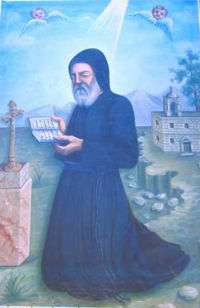 | |
| Mar Awtel | |
| Born | 250 Magdal, Lycia, Asia Minor |
| Died | 327 Lycia |
| Venerated in | Eastern Orthodox, Oriental and Catholic Churches |
| Major shrine | Kfarsghab |
| Feast | Jun. 3, Aug. 27 |
| Attributes | Monk and Hermit |
| Patronage | The Village of Kfarsghab, Lebanon |
Life
There are several versions of the life of Mar Awtel. This is the version of the Maronite Sinksar along with the versions presented by Youakim Moubarac.[1]
Saint Awtel is celebrated by the Eastern Orthodox Church, the Jacobites and the Maronites. His place and date of birth vary according to the sources. From an unknown place in modern Turkey for the Maronite Sinksar and born in the 3rd century AD, he is from Lycia for the other sources and he lived during the 6th century AD. His feast day varies also according to the different traditions. But most sources have corroborating deeds: he escaped a forced marriage arranged by his family, spent some time in Byzantium, delivered his fellow passengers during a severe storm, went back to his place of birth after the death of his parents and finally became a monk then a hermit.
Version of the Maronite book of saints (Sinksar)
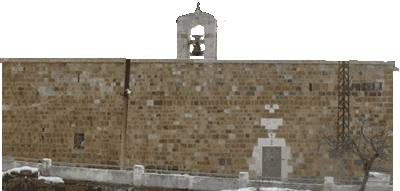
Mar Awtel was born in mid-3rd century. As a youth he was converted to Christianity and baptised. He pledged his virginity to God but his father wanted him to marry and thereby break his pledge of celibacy. To escape he left for the city Byzantium.
While travelling on route in a boat he encountered a severe storm endangering the boat and all on board. He prayed for deliverance and the boat was saved and as a consequence those on board were converted to Christianity and baptized.
He remained for 20 years in Byzantium until his father died, whereupon he returned to his home and became a monk. He performed many miracles, one of which was the cure of a pagan man. This cure was the reason for the conversion and baptism of ten thousand pagans. After being a monk for 12 years he became a hermit until he died in 327.
Version of Fr. Louis Cheikho
Father Youakim Moubarac presented the following version of Father Louis Cheikhô :.[2]
Father Sheikho found some information about Mar Awtel in the Jacobites book of saints, in a handwritten copy belonging to Patriarch Ignatius Ephrem II Rahmani. It is also mentioned in the Bibliotheca Orientalis of Assemani and in the calendar of Çlîba the Jacobite, on the dates of October 9 and June 3.
Of all those references, he concluded that Awtel or Awtilios was born in a city called Magdal or Magdaloun in the land of Lycia in Asia Minor, in the 6th century A.D. His two parents were pagan but he was converted very young, became Christian and ran away from the paternal home to avoid marriage. He boarded and ran away to the city of Moumista (probably al-Maççîça) delivering his fellow passengers from a tempest where they would have perished. He came to Constantinople, led an ascetic life in one of its monasteries, then came back to his fatherland before spending some time in the region of Antioch,[3] then back in Lycia. There, he converted the pagans of this region, christened them and ended his life in the desert in a monastery which he built nearby and where he lived till his death. In the calendar of the antiochian Church of al-Bîrûnî a martyr called Uwaytilyos is mentioned on the date of September 23. But it is not proven whether it is Mar Awtel or another saint.
Additional information
Father Cheikho [4] found also that the Byzantines would have called Saint Awtel, according to Fr Peeters, Agios Attaros and that they celebrated his feast day between the 2nd and the 7th of June. He delivered his fellow passengers who wanted to make him a slave by capturing him. According to the Jacobite book of saints, he remained 20 years in Constantinople, went back home after the death of his parents, spent some time in Seleucia[5] and in Antioch before reaching Lycia. There, he joined the monastery of Mar Âba, became monk and made miracles. He left the monastery because he did not want to be elected superior. He was served in his ultimate retirement in the desert by a man whom he had cured from the bite of a snake.
Saint Awtel's Church, Kfarsghab
The history

Saint Awtel's church in Kfarsghab, Lebanon is the only church in the country dedicated to this saint. It is built on a rocky promontory presenting steep faces of around 30 meters altitude, commanding the approaches through the Qadisha Valley. Its location is clearly that of a fortified place, echoing the etymological meaning of Kfarsghab#Etymology, "the fortified village". The first mention of Saint Awtel Church is a date for its renovation in 1470.[6]

Between 1776 and 1778, the church was extended to accommodate the increasing population of Kfarsghab. The achievement of this renovation is attested by a Garshuni stone inscription in Syriac placed over the main entrance that reads as follow:
- "Achieved the construction of this blessed temple
year one thousand seven hundred and seventy six by the zeal of Sheikh Abou Youssef Elias".

The Church is separated into two sections: men in front and women in the rear. And in 1795, an intricate woodwork was completed to separate the two sections. It was commemorated by a Garshuni inscription in Syriac Serta Script that reads as follows:
- Left Side:
"This woodwork was achieved by the hand of Master Dumiati [from Damietta, Egypt] in the month of February of year 1795 and that was"

- Right Side:
"under the supervision of Father Jibrayeel and Father Brahim priests of the village and the donor was Sheikh Estephan Elias. [May] the Saint patron of the location reward him".

In 1882, the church underwent renovation that was commemorated by engraving on the main entrance door in a mix of Garshuni and Arabic as follows:
- "Enter into the domain of the Lord
painted in year 1882
and bow in his temple".
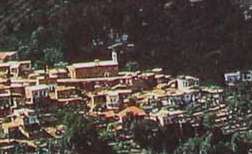
In the 1950s, A modern bell tower in white stone and red tiles was added over the women entrance to the west. It was quite different from the style of the church. Eventually, it was dismantled in the 1980s restoring the architecture to its origin.
In the 1960s, a painting was commissioned to Saliba Douaihy, a young but already established Lebanese artist. This painting of Saint Awtel could be still seen over the altar inside the church.
In the 2000s, the square around the church was renovated and embellished in old stone reflecting the beauty of the architecture and the majesty of the site.
The Architecture and style
The Church layout is that of old small Maronite churches, with a single apse and a single nave typical of the 12th and 13th centuries Maronite churches.[7] The interior is divided according to Patriarch Estephan El Douaihy’s standard plan with minor differences due to the small size of the church.[8]
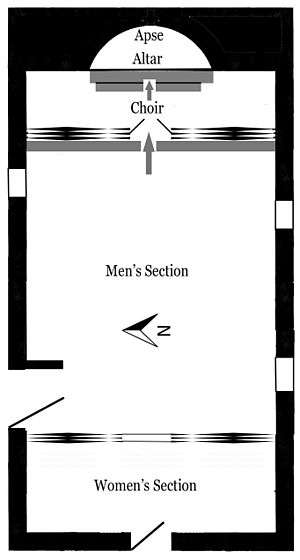
A plain rectangular shape is terminated at its Eastern side by a semicircular half-domed apse. The apse's vault is ornamented with paintings of angels/cherubims on a light blue background. The altar, made of white marble, is centred into the apse and pushed into its wall. The icon representing Saint Awtel is hanging above the altar in the middle of the apse. The altar is separated by few steps from the chancel, which in turn is separated from the nave by other few steps and an iron parapet.
The nave is roofed by a series of crossed vaults. It is divided by an intricate wooden separation into two sections: the one in front reserved for men and the rear reserved for women. Each section has two ranks of natural wooden benches and its own thick wooden door. The wooden divider is a piece of delicate art and we know from the inscription commemorating its consecration that it was the work of a skilled artisan from Damietta, Egypt, a city still known today for its excellent wood artisans.
A white coating covers the inside walls. Natural light comes through two narrow higher windows on the Southern wall and one lower window on the North wall.
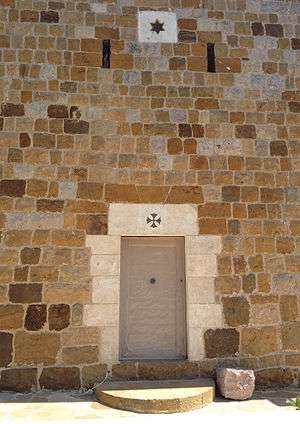
Three higher apertures can be seen on the western wall above the women's entrance: two rectangular narrow apertures and above them in the middle the third aperture made in white stone in the shape of a hexagram, a six-pointed star. The Women's door is encased into atypical heavy slabs of white limestone, and bears on the upper slab an unusual cross. The shape of the cross doesn't figure in the Maronite crosses tradition. It is a combination between a coptic cross and an Occitan cross. The Occitan cross is attributed to Raymond IV of Toulouse, whose family reigned in the county of Tripoli during the Crusades from 1109 till 1289 AD. Kfarsghab was administratively part of the county of Tripoli, which could be an explanation of the origin of this unusual cross.
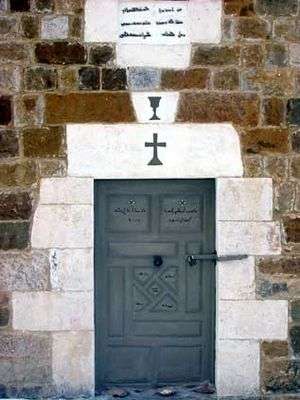
The men's door is also encased in heavy slabs of white limestone. The upper stone bears an engraving of a simple graded cross. A smaller stone has a chalice engraved on it. Then, an engraved white limestone plate tops the whole commemorating the extension of the church in 1776. The door is of heavy oak wood, engraved with biblical verses and a date of renovation in 1882.
The flat roof and the roughly hewn stone of the outside walls give the church an aspect of simplicity and austerity. The bell tower situated at the northern edge of the roof slightly to the left of the main entrance is the example of this minimalistic style as it is formed by a simple stone arch housing a medium size cast iron bell.
The church is surrounded by a vast square on the Northern and Western sides, cobbled in natural stone. The square is delimited by a natural stone parapet.
See also
References
- Moubarac, Youakim - Pentalogie antiochienne / Domaine Maronite - Tome II - Volume I - pages 17-18 - éditions du Cénacle Libanais - Beyrouth - 1984
- This article is based on the work of the great historian Father Louis Cheikho sj and especially on his work Awliya" Allah fi Lubnan edited in Beirut in 1914. Youakim Moubarak translated it to French and enriched its contents and published it in his Pentalogie Antiochienne / Domaine Maronite - Tome II - Volume I - year 1984 - Editor Cenacle Libanais - Beirut - Lebanon.
- The city of Antioch-on-the-Orontes (modern Antakya) is located in what is now Turkey. Located on the eastern side of the Orontes River, it was founded near the end of the 4th century BC by Seleucus I Nicator, who made it the capital of his empire in Syria. Seleucus I had served as one of Alexander the Great's generals, and the name Antiochus occurred frequently amongst members of his family.
- magazine Al Maxreq, year X, 1907, page 672-672, Beirut, Lebanon
- Seleucia in Syria functioned as the sea-port of Antioch and lay near the mouth of the Orontes. Paul and his companions sailed from this port on their first missionary journey (Acts 13:4). This city was built by Seleucus Nicator, the "king of Syria." It is said of him that "few princes have ever lived with so great a passion for the building of cities. He is reputed to have built in all nine Seleucias, sixteen Antiochs, and six Laodiceas." Seleucia became a city of great importance, and was made a "free city" by Pompey. It is now a small village, called el-Kalusi.
- Abi Khattar, Sheikh Antonios, known as AïnTourini, Moukhtassar Tarikh Jabal Loubnan, in the version of the father Ignatius Tannous AlKhoury revised by Dr. Elias Kattar, editor Lahd Khater, Beirut 1983. OCLC 21044417, page 139. In fact, the author refers this date to a text of the Patriarch El Douaihy, not present in the events of that year in Douaihi's most important book Tarikh Al Azminah. On the other hand, the historians (including AïnTourini) agree on saying that the construction of the church of Saint Awtel goes to the same period and on the same style as those of Saint Roumanos in Hadchit and another church in Madinat Al Ras (village now extinct). However the Patriarch El Douaihy dates the construction of Saint Roumanos church to the year 1518. in El Douaihy, Patriarch Estephan, Tarikh Al Azminah, in the version of the Abbot Boutros Fahd, editions Dar Lahd Khater, Beirut – 3rd Edition. OCLC 41272562, page 397. Therefore, the first church of Saint Awtel could have been renovated at the end of the Fifteenth Century
- Atallah, Micheline, Saint Aquilina's Church And Sanctuary Part III, Journal of Maronite Studies, Vol. 3, Issue 4, October 1999
- Abdallah, Charbel, L'architecture d'une église maronite selon le patriarche Douaïhy, Faculté Pontificale de Théologie de l'Université Saint-Esprit de Kaslik (Liban), 24 November 2010, last accessed on March 4, 2014.
External links
- (in English and French) The tradition of Mar Awtel, saint patron of Kfarsghab